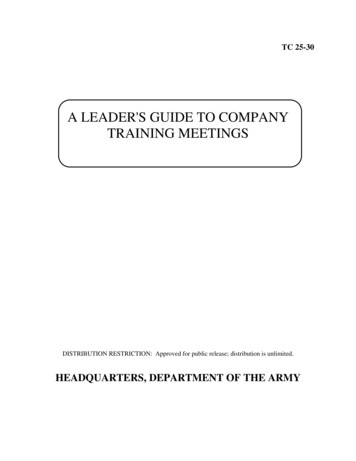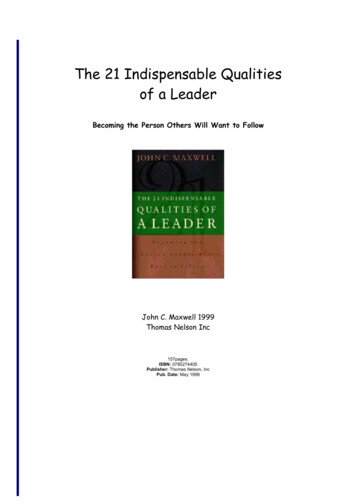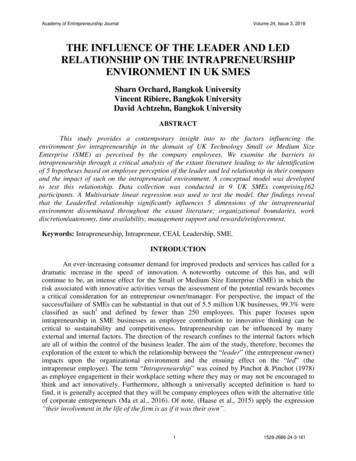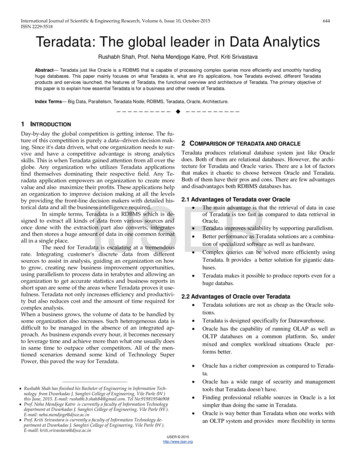
Transcription
TC 25-30A LEADER'S GUIDE TO COMPANYTRAINING MEETINGSDISTRIBUTION RESTRICTION: Approved for public release; distribution is unlimited.HEADQUARTERS, DEPARTMENT OF THE ARMY
CHAPTER 1Company-Level Training ManagementOVERVIEW OF TRAINING MANAGEMENTDefinitionEffective training is the Army’s number one priority duringpeacetime. Training management is the process used by Army leaders to identify training requirements and then plan, resource, execute and evaluate training. At the company level, as at all levels ofcommand, the training meeting is an essential element of the training management process. Training meetings are periodic meetingsconducted by leaders to review past training, plan and prepare future training, and exchange timely training information betweenparticipants.Battle Focused TrainingBattle focus is the process of deriving peacetime training requirements from wartime missions. The purpose of developing a“battle focus” approach to training is to allow commanders toachieve a successful training program by consciously narrowing thefocus of the unit’s training efforts to a reduced number of vital tasksthat are essential to mission accomplishment. Once the commanderhas developed a battle focus approach to training, the next step is toensure that the scarce resources of time and training dollars are notwasted. For a more in-depth discussion of battle focused training, seeChapter 1 of FM 25-101.1-1
TC 25-301-2
TC 25-30Training Management CycleThe training management cycle begins with the assignment ofa wartime mission and the establishment of a mission essential tasklist (METL). For a more detailed discussion of METL development,see Chapter 2 of FM 25-101. Once the METL is developed, it becomesthe training focus for the unit, or the “where we want to be” in termsof training proficiency. The training management cycle continueswith a training assessment. This assessment is a “where we are”check in terms of training proficiency for the unit. These two basicelements of the training management cycle define the framework ofthe training plan. Knowing where you are (training assessment) andknowing where you are going (METL) are half the battle to conducting effective training.The training management cycle is a continuous cycle of planning, executing, and assessing. Figure 1-1 shows the training management cycle. An important aspect of the cycle is the continuous useof feedback to refine the training plan. This feedback takes manyforms: personal observations, after-action reviews, and informalevaluations, to name just a few. A primary forum for the discussionof training assessments is the training meeting.TRAINING MANAGEMENT RESPONSIBILITIESBattalion Commander and StaffThe battalion command and his staff play a key role in thesuccessful execution of company-level training. Besides providingcommand guidance and long-range training plans, the battalioncommander sets the tone for establishing a safe, realistic trainingprogram that achieves the unit’s training objectives. The commander must be personally involved in all phases of the trainingmanagement cycle. Most importantly, the battalion commander isthe key leader with the power to protect companies from training detractors by ruthlessly enforcing the lock-in of major events agreedupon during training briefings and contained in signed trainingschedules. The Command Sergeant Major (CSM) is personallyresponsible for advising the commander on all matters pertaining to1-3
TC 25-30enlisted soldiers. In this capacity the CSM has a mandate to ensurethat soldiers receive the best possible training. Additionally, theCSM, with other NCO leaders, helps in the integration of collectiveand individual soldier training tasks. The CSM assists the commander in ensuring that NCOs select appropriate soldier tasks tosupport each collective task selected for training. Figure 1-2 showsthe linkage between the CSM (and NCO leaders) and commanders’training responsibilities.Company CommanderThe company commander is the training manager for thecompany. Historically the commander has been responsible foreverything the unit does or fails to do. This is especially true fortraining. Company commanders personally train platoon leaderswith their platoons, and evaluate section, squad, team, and crewleaders with their units. If training needs to be scheduled, it is thecompany commander’s responsibility to see that it gets put on thetraining schedule.Executive Officer (XO)As second in command of the company, the XO must prepare toassume control of the company-level training management program.The XO must be aware of command guidance, understand how toschedule training, and request the appropriate resources. Additionally, the XO is usually tasked with significant additional duties thatcan have a major impact on the training schedule. For example, theXO may also be the company maintenance officer. In this capacity,he advises the commander about scheduled vehicle/equipmentservices.Platoon Leader/ Platoon SergeantPlatoon leaders and platoon sergeants (PSGs) are responsiblefor the training proficiency of their platoons. They assess the training proficiency with input from section/ squad leaders to identify theindividual soldier and collective tasks that need training. Platoon1-4
TC 25-301-5
TC 25-30sergeants, who may also serve as platoon leader when no officer isassigned, must be equally involved with the collective and individual proficiency of the platoon.The platoon leader— Assesses the training proficiency of collective tasks. Plans training. Rehearses trainers. Evaluates leader, team, and crew-level collectivetraining. Conducts platoon training meetings.The platoon sergeant— Assesses and evaluates the training proficiency of individual soldier tasks. Plans conduct of training. Selects individual soldier training tasks. Selects opportunity training. Provides input to the platoon leader’s collective taskassessment. Assigns trainers. Rehearses trainers. Conducts preexecution checks. Ensures soldiers are prepared for and attend training.First SergeantThe first sergeant (lSG) holds a special place in the companytraining management arena. As the senior enlisted soldier in thecompany, the 1SG is charged with maintaining a high level of proficiency on soldier tasks and the NCO leader development program.1-6
TC 25-30First Sergeants keep tabs on the “training pulse” of the company.They do this in many ways, not the least of which is the constantmonitoring of soldier training. This can be formally, such as an announced inspection, or informally, such as a periodic review of NCOleader books. First sergeants also have formal responsibilities during Quarterly Training Briefs (QTBs). During these briefings, lSGsdiscuss specific training topics, such as— CTT survival skills. An assessment of the unit’s battle focused soldier and NCOleader training programs. Soldier training proficiency feedback from current trainingevents. Company education, Army Physical Fitness Test (APFT),weapon qualification data, reenlistment status and overweight programs.Other LeadersOther leaders have training management responsibilities. Sliceleaders must keep the company commander informed of their training needs, and their ability to help the unit with specialty training.The supply sergeant and maintenance team chief provide input tothe commander so important training events get scheduled.1-7
TC 25-30LONG-RANGE PLANNINGDefinitionAt the company level, long-range planning encompasses training that is planned for and resourced 12 months (active component(AC)) to 36 months (reserve components (RC)) in advance. Exampleresources that are planned for include training areas, ammunition,and fuel. By conducting long-range planning, units can predict theirneeds and coordinate for support well in advance of the plannedtraining.Planning CalendarsLong-range plans are translated into planning calendars foruse by subordinate units in their planning process. An AC battalioncalendar covers one training year, normally coinciding with a fiscalyear (FY). An RC battalion calendar covers three training years.This “planning horizon” allows companies to plan and prepare appropriately for major training events. It also allows soldiers to makeplans for leave, military schooling, or specialty training without conflicting with major training events.Planning calendars provide specific information on trainingevents. Generally, each separate event has a beginning and endingdate, as well as a brief description of the activity. The calendar is displayed in the Standard Army Training System (SATS) format.SHORT-RANGE PLANNINGDefinitionShort-range planning is a refinement of the long-range plan.The short-range plan defines in specific detail the broad generalguidance found in the long-range plan. The short-range plan beginswith a training assessment, and results in specific command training guidance (CTG). Short-range planning at the battalion and company level has a planning horizon of 3 months (AC) and 12 months(RC). For AC battalions, short-range plans are prepared for each1-8
TC 25-30quarter, and are published 6 weeks before the start of the quarter.For RC battalions, yearly guidance is published 3 to 4 months beforethe start of the training year.Command GuidanceCommand guidance is the product of the short-range plan. Atthe company level, command guidance comes from the battalioncommander. The commander’s training guidance is a document thatdescribes the training strategy and assigns specific training objectives and priorities for the next quarter (AC) or year (RC). Battalioncommanders base their command training guidance on input frombrigade and higher commanders, along with planning recommendations from subordinate leaders. Command training guidance is veryspecific in nature, and normally addresses topics such as— Commander’s assessment of METL proficiency. Training priorities. Integration of slice training (other units that habitually fightand train together). Impact of time management systems on scheduled training(duty company, for example). Integration of soldier, leader, and collective training. Evaluations, inspections, and feedback.1-9
TC 25-30Quarterly/Yearly Training BriefingsEach quarter for active component units (yearly for RC units)company commanders and first sergeants brief their brigade commanders on training-related issues. The briefings discuss past,present, and future training expectations. At this briefing, companycommanders seek the approval of their training plans. Once approved, the brigade commander agrees to provide appropriate resources, and then promises to ruthlessly protect the company fromunprogrammed training detractors.Quarterly and yearly training briefings (YTBs) are high priority events and impact the entire chain of command. It is importantthat all primary leaders (lSG, platoon leader/PSG) and slice leadersattend the training briefing with the company commander. Thebriefing is designed to create confidence throughout the chain ofcommand by ensuring that leaders at all levels understand the intent of the senior commanders. As a result, company commanderscan make effective, independent training decisions as they executethe approved training plan.NEAR-TERM PLANNINGDefinitionNear-term planning identifies specific actions required toexecute the short-range plan. Near-term planning covers a four- tosix-week period before the execution of training for AC units (fourmonth period for RC units). Near-term planning is conducted weeklyfor AC units (monthly for RC) and consists of training meetings atbattalion and company levels.TRAINING MEETINGSTraining meetings are conducted weekly (monthly for RC) atplatoon and company level and are the primary forum for providingguidance for forming the training schedules.1-10
TC 25-301-11
CHAPTER 2Training Meeting Planning ProcessTRAINING MEETING OBJECTIVESThe objectives of the company training meeting are to reviewcompleted training, deconflict training issues, plan and prepare future training, and exchange timely training information betweenparticipants. With these objectives in mind, the training meetingprocess can be described as a three-phase operation: Phase I: Assessment (completed training). Phase II: Coordination. Phase III: Future planning.AssessmentThe assessment phase seeks to describe the effectiveness of thetraining conducted since the last training meeting. Leaders from allsubordinate units brief changes in training status. The commandertakes this information, combines it with his personal observations,and comes up with a commander’s assessment.CoordinationWith the formulation of the commander’s assessment complete,the next phase is the coordination of future training that has alreadybeen planned. Detailed and specific instructions are added to eventsthat already appear on the training schedule. Individual subordinateleaders may brief the company leadership on specific training exercises or events.Future PlanningWith coordination complete, the final phase of the trainingmeeting process is to plan for future training. Subordinate leaderswork with the commander to develop future training plans that support the assessment conducted in Phase I (assessment). During thisphase the company commander ensures that scarce training time iseffectively used.2-1161-015 0-94-2
TC 25-30WHO ATTENDS AND WHYInternal CompanyThe company training meeting is a high priority mission for theleadership of the company. Attendance for selected leaders is mandatory. Figure 2-1 shows a list of leaders who normally attend company training meetings.The company commander is responsible for the efficient conduct of the training meeting. Although all leaders participate in thetraining discussion, it is the commander who leads the meeting andprovides direction and focus.The XO is the second in command, and as such, runs the training meeting in the commander’s abse
schedule training, and request the appropriate resources. Addition-ally, the XO is usually tasked with significant additional duties that can have a major impact on the training schedule. For example, the XO may also be the company maintenance officer. In this capacity, he advises the commander about scheduled vehicle/equipment services. Platoon Leader/ Platoon Sergeant Platoon leaders and .











